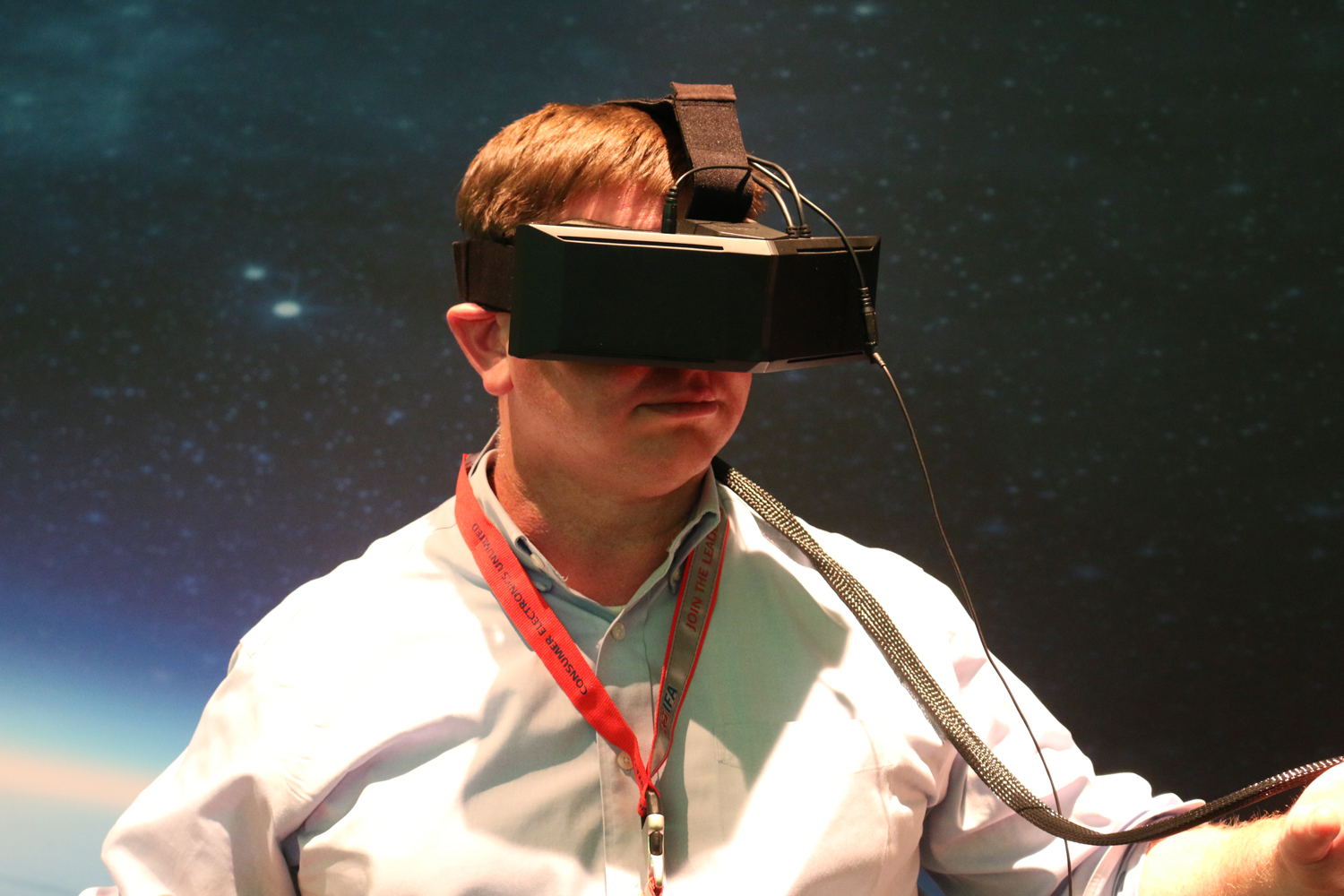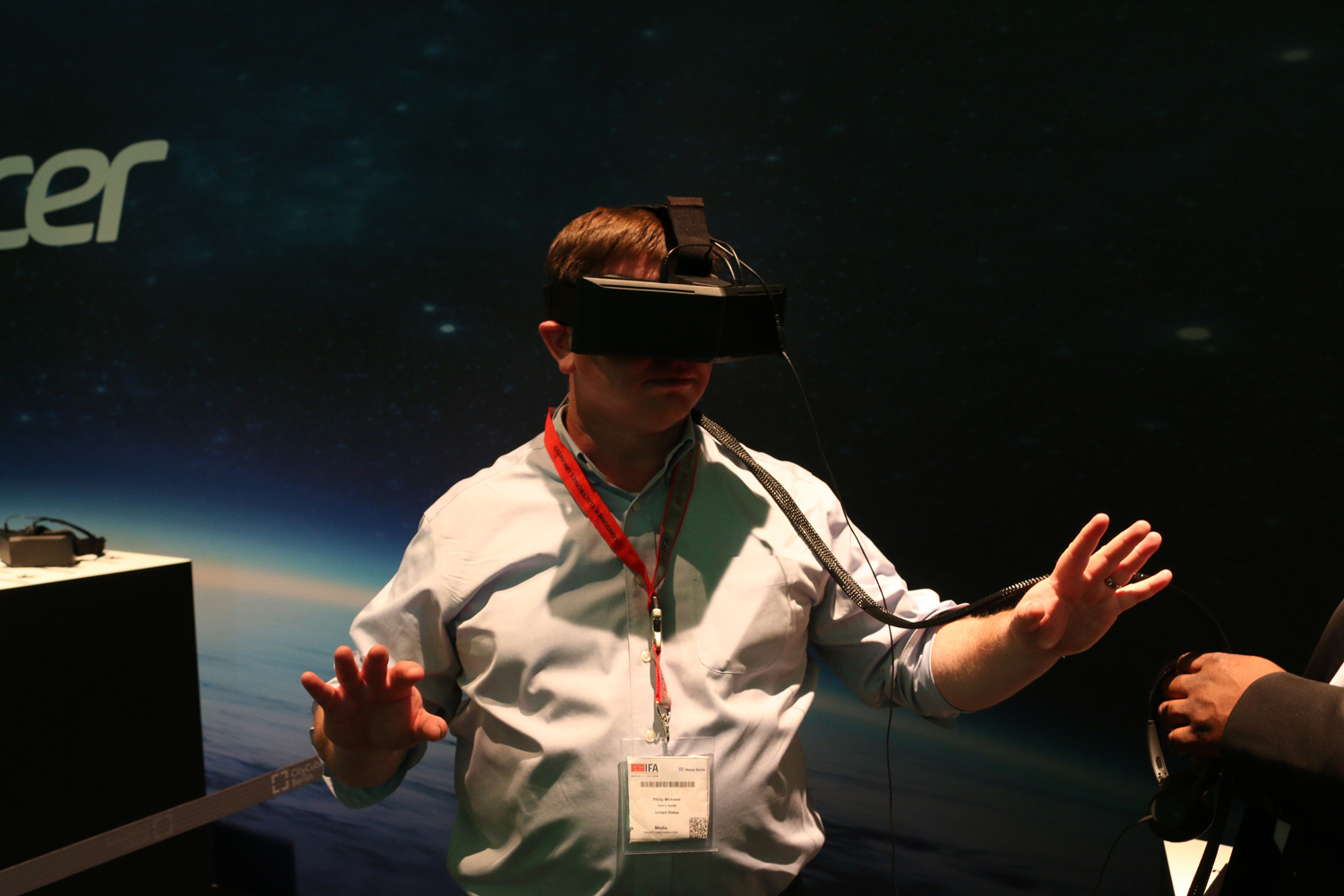I Just Experienced the Next IMAX in VR and My Knees Buckled
StarVR, a joint venture between Acer and game-maker Starbreeze, is shipping to customers, and Imax wants to use it to make movie-going more immersive.
BERLIN — One day, you'll be sitting in a movie theater, watching the end of a big-screen blockbuster, most likely involving a superhero the way Hollywood green-lights things these days. But instead of filing out of the theater when the credits roll, instead you'll head into another room where you'll strap on a headset and watch a special add-on or extra about the movie you just watched, all in glorious virtual reality.

That day is not far off, if the companies working to develop immersive VR experiences for movies, theme parks and other attractions have anything to say about it. Acer wrapped up its press conference at IFA today (August 31) to announce that the VR headset it's developing with in a joint venture with Starbreeze is now shipping to customers. And one of those customers — Imax Corp. — plans to put that headset to use at a VR center opening up later this year in Los Angeles.
If it's successful — and from my briefing time wearing the StarVR headset today, I would give say there's a pretty good chance it will be — Imax's incorporation of VR into the movie-going experience means the show doesn't necessarily end once the credits role.
When the demo switched to the wider field of view, my knees actually buckled, and the engineer running the demo had to grab my arm to steady me.
Acer announced its joint venture with Starbreeze, a game developer, earlier this year, as the two companies revealed they were collaborating on a headset dubbed StarVR. Both Acer and Starbreeze remain mum on the exact specs of the headset, other than the fact it promises 5K resolution and a 210-degree field of view. The FOV for most consumer headsets you've likely tried out tops out at 110 degrees.
That's going to mean a more immersive VR experience than you might be used to. "We want to create The Matrix," said Starbreeze CEO Bo Andersson, referencing the 1999 blockbuster, before clarifying that his vision wasn't to create sentient machines that subdue humanity. "We don't want to control you," he quickly added, "but we want to recreate that experience."

Starbreeze and Acer are off to a good start, if my experience wearing the headset is any indication. The conditions for my demo were less than ideal. It took place in a crowded exhibit room, and I only got to wear the StarVR headset for maybe 90 seconds before other journalists got their turn. But it was still fairly eye-opening.
The demo began with a party scene, constricted to a 110-degree field of view. Suddenly, the action expanded to 210-degrees, as all sorts of characters appeared in the corner of my eye. (The fellow wearing a clown mask and waving a pistol will be the first thing I see when I close my eyes tonight.) The wider field of view expanded my peripheral vision in the virtual world, so that I could see things as I could in the real world — all without the limiting black bars that might otherwise keep me from immersing myself fully in what I was seeing.
In fact, I may have become a little too immersed. I'm usually not prone to VR-related nausea, but when the demo switched to the wider field of view, my knees actually buckled, and the engineer running the demo had to grab my arm to steady me.

Starbreeze and Acer haven't talked too much about the audio since, as one rep told me, those specs are still evolving. For this demo, I wore separate headsets that may or may not be in the final design, but they did help convey the 360-degree audio that will be a part of the StarVR experience.
Full pricing won't be revealed until 2017, but that shouldn't concern you — you're not the target customer. Acer and Starbreeze are developing the StarVR for businesses: theaters, theme parks and other attractions where VR could augment the entertainment experience.
And that's where Imax comes in. The film company sees VR headsets as a chance to do with virtual reality what it did with large format movies, drawing on its existing relationship with theaters, studios and directors.
"Our hope is that it reinforces the Imax mandate to take people to place they haven't been that they want to go to and puts them inside that experience," Rob Lister, Imax's chief development officer told me.
Imax plans to test out that experience this fall. Some time during the fourth quarter, it will launch a VR showcase in the Los Angeles area, described by Lister as a standalone location that will feature about "15 pieces of good [VR] content." The idea is that visitors will show up at Imax's showcase, try on the StarVR headset and experience some immersive short movies firsthand.
Imax is eyeing other potential test sites in New York, London and Shanghai, though those would potentially be in partnerships with multiplex theaters, Lister said.
And that's where all this could be headed. In addition to a full-length feature, a movie studio would create a supplemental VR film about 7 to 10 minutes long that could be treated as an add-on to the movie-going experience. In this scenario, Lister said, you'd tack another $10 onto your movie ticket for an interactive experience related to the movie. It would take place in a separate part of the theater — an area without seats where you could move around freely in a 6 x x 6- or 8 x 8-foot space, interacting with the virtual world unfolding before you with the Star VR glasses.
We're focusing on movies here, because that's Imax's bread-and-butter. But other entertainment companies could easily find a use for StarVR's headset, whether it involves gaming, entertainment or some other customer-facing experience that would benefit from StarVR's immersive field of view.
- Oculus Rift vs. HTC Vive: The Vive Is Better (for Now)
- Virtual Reality Films Put You in the Picture
- I Touched Augmented Reality with Meta 2
Sign up to get the BEST of Tom's Guide direct to your inbox.
Get instant access to breaking news, the hottest reviews, great deals and helpful tips.
Philip Michaels is a Managing Editor at Tom's Guide. He's been covering personal technology since 1999 and was in the building when Steve Jobs showed off the iPhone for the first time. He's been evaluating smartphones since that first iPhone debuted in 2007, and he's been following phone carriers and smartphone plans since 2015. He has strong opinions about Apple, the Oakland Athletics, old movies and proper butchery techniques. Follow him at @PhilipMichaels.

